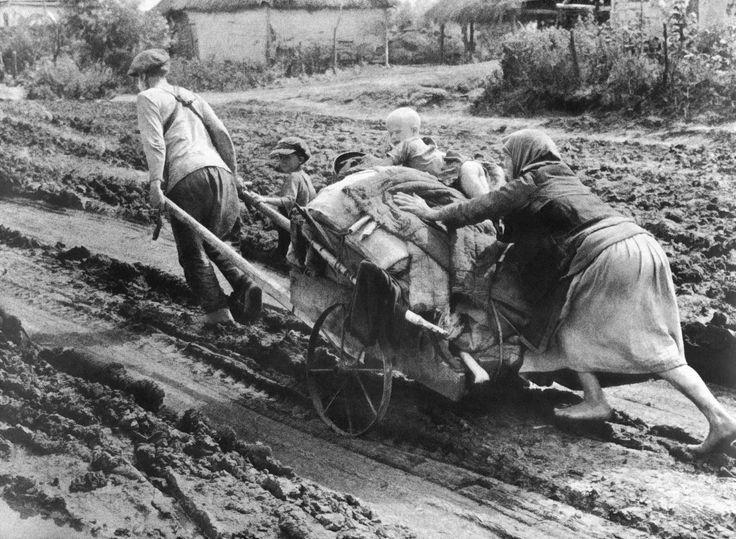
Great Patriotic War: Soviet Regions

Figure 1.--Here Ukranians in Dnipropetrovsk / Dnepropetrovsk in south central Ukraine are trying to flee the Germans. It looks like the rains are just beginning. Before the winter snows began, the Germans faced roads that became rivers of mud. At the time of World War II, there were no improved roads connecting Soviet cities and of course the ditnces were huge. As a result the Panzers were unable to race from city to city as they did in the Netherlands, Belgium, and France.
|
|
Much of the World War II Eastern Front was fought out in two regions, Belarus and the Ukraine. Other areas included the Crimea, southern Russia, and the Caucauses. There was also heavy fighting in the Baltics, but mostly when the Soviets retook the Baltics (1944). Here we are talking abour independent countries occipied by the Soviet Union and annexed (1940) rather than Soviet regions. All three Baltic Republics were reannexed by the Soviet Union after the War. Notably only the western regions of the Russian heartland were occured by the Germans. The fighting took up a different character in each of these various regions. There was considerable anti-Soviet sentiment in all of these regions. It was the Russian heartland that as in the Civil War became the Soviet bukwark. The Germans as a result of Barbarossa penetrated into the Russian hearland (September-November 1941). They were, however, driven back by the Red Army Winter offensive before Moscow (December 1941). Thus while the Wehrmacht penetrated deep into the Soviet Union, for the most part the fighting in the east took place in the non-Russian areas west of the Russian heartland. Anti-Soviet feeling was stongest in the Baltics. The same was true in the Ukraine. NAZI barbarity managed to turn the population against them and into the hands of the Soviets. NAZI race policy managed to turn potential allies against the Germans. People in these areas had to chose between two blood thirsty totalitarian powers. Those who joined the NAZIs were pursued as war criminals after the War. The Soviets, however, committed many war crimes themselves, crimes thatwere not procecuted after the War. NAZI race policy proved to be a major factor in the outcome of the War in the East.
CIH -- WW II

Navigate the CIH World War II Setion:
[Return to Main Great Patriotic War campaign page]
[Return to Main Great Patriotic War page]
[Return to Main World War II page]
[About Us]
[Aftermath]
[Biographies]
[Campaigns]
[Children]
[Countries]
[Deciding factors]
[Diplomacy]
[Geo-political crisis]
[Economics]
[Home front]
[Intelligence]
[POWs]
[Resistance]
[Race]
[Refugees]
[Technology]
[Totalitarian powers]
[Bibliographies]
[Contributions]
[FAQs]
[Images]
[Links]
[Registration]
[Tools]
[Return to Main World War II page]
[Return to Main war essay page]
[Return to CIH Home page]
Created: 3:32 AM 5/13/2016
Last updated: 3:32 AM 5/13/2016



